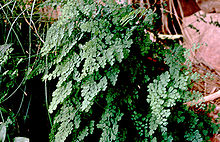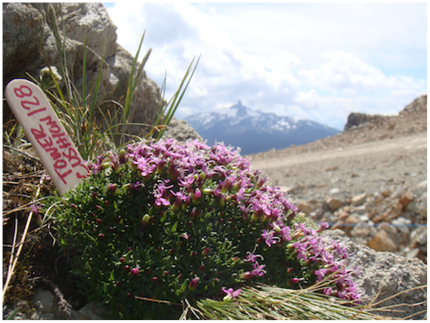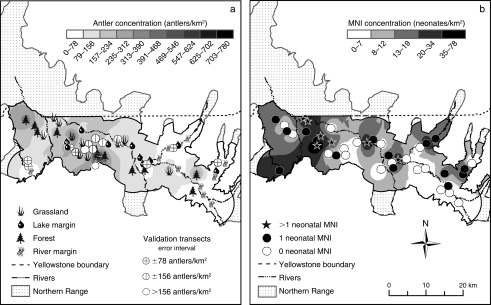Imagine you are walking through an arid desert region, in the height of summer. There are canyons and rock formations of soaring sandstone all around you. The vegetation is dry and scrubby, designed to withstand long periods of drought. The stream beds around you are dry and will remain that way until winter or spring. It’s a beautiful but extremely harsh environment. Suddenly, your trail turns a corner and before you is a patch of lush green vegetation – ferns and grasses and flowers and algae – growing seemingly straight out of the rock, some even upside down. As you approach you see that that the area is cool and damp and shady, with water coming seemingly out of nowhere and disappearing in a dwindling trickle below. It is the complete opposite of the habitat surrounding it in nearly every way, and by all logic, shouldn’t exist.
You’ve just encountered a hanging garden, a peculiar plant community found in the greater Colorado Plateau. Hanging gardens, at their most basic, are places where water seeps out of bare rock, often year round, in an otherwise desert environment and allows water-loving plants to thrive in places where they would otherwise never be able to grow. Not only are they lovely oases, but they are often important resources for the communities around them, and a refuge for rare and endemic species.
First thing first: How and why does a hanging garden form? Let’s start with the seep. In the areas which hanging gardens are found, the geology consists of layers of highly porous sandstone (laid down in ancient, wind swept deserts) and ones of impermeable sedimentary rock which formed the bottoms of prehistoric lakes. Rivers have cut through these layers to form the deep canyons of the southwest, and it’s this particular arrangement of rock types that allows theses seeps to form.
When rain falls on bare sandstone it finds its way into the rock, both through the rock itself and through jointing in the sandstone that allows the water to make its way downward until it hits one of the impervious layers of stone. It then collects in the porous layer, as if the former lake still existed but is now underground and happens to be full of rock as well as water. But the water has to go somewhere, and following gravity it will move along the impermeable barrier until it finds a way to continue the downward journey. Sometimes it finds joints and cracks in the impervious layer and flows through these into the next layer of porous sand stone, if there is one, or into underground aquifers. But sometimes it has to move nearly horizontally, in which case it will follow any slight downward slope of the old lake bottom and any available joint system in search of a place to go.
In places where the layers have been cut through, the water often finds its exit in the wall of the canyon. These seeps can range from barely a moist patch on the rock face to an ephemeral trickle to a year-round gushing stream or pool system, sometimes flowing into an above-ground river. But if there is moisture in the desert, it will be colonized somehow, often surprisingly quickly. A true hanging garden forms when a seep comes out in a place that is shaded for enough of the day to keep the temperature cool and relatively stable throughout both the day and night.
Hanging gardens usually have very thin, poor soils, formed by natural erosion of the rock by the water and through the action of
the first species of plants to colonize the area, ones that take hold on the rock itself or on the calcareous deposits (known as tufa) that are often left on the rock by calcium-rich water. The tufa contains not just calcium but other nutrients trapped from the rainwater as it flows through the ground, and some plants can root directly in it in lieu of soil.
Hanging gardens take three distinct forms, depending on the geology around the them, the thickness of the rock layers, and the placement of the joints in the rock. The most gravity-defying are the “window blind” gardens which appear to grow directly out of a sheer rock face, when the joint between the permeable and impermeable layers of rock is flush with both layers. This type of garden, while impressive, often supports smaller and fewer species the other types. A terrace garden happens when the permeable layer has eroded further than the impermeable layer of rock, forming a shelf on which the water can collect and eventually flow over the edge, and where plants can get a foothold more easily than on a vertical face. Soil collects more easily on the ledges and so may support less acrobatic species.
Finally, the type of hanging garden that is usually richest in species an alcove garden, where the sandstone has eroded away to form an overhanging cave, usually with a pool (known as a plunge pool) at it’s base. This type of hanging garden actually has three distinct zones in which different kinds of plants may be found. The ceiling of the overhang, from which some species may grow nearly upside down, the sheer back wall, and the floor upon which soil and detritus accumulate. The ceiling may contain ferns and adventurous flowering plants, such as maidenhair fern (Adiantum spp.), monkeyflowers (Mimulus spp.) The back wall is often primarily covered in algae, although some of the ceiling species may colonize there as well. The floor will have the highest number of species, often including sedges and grasses found in regular riparian areas, columbines (Aquilegia spp.), shooting stars (Dodecatheon spp.), and even orchids (such as the helleborine orchid, Epipactus gigantea).

Aquilegia grahamii, a columbine known only from hanging gardens in three canyons of the Uinta Basin, an area with high levels of oil drilling and greatly imperiled.
As you might imagine, the shelter provided in a hanging garden is not limited just to plants. They support rich communities of insects and other arthropods, as well as many microscopic creatures. Depending on the size and location, any number of vertebrate species may make use of the garden as well, particularly if it contains a pool of any kind. Birds, rodents, and even larger animals may drink the water, and small birds and mice may make their homes in the garden either permanently or temporarily to shelter from a drought. The seeds and vegetative parts of the plants, as well as invertebrate inhabitants can provide a food source. And amphibians make use of the pools to live and spawn in. Hanging gardens are ecosystems unto themselves, both large and tiny – some of them are big enough to support cottonwood and willow trees!
Hanging gardens don’t just contain cool looking plants, but may also shelter rare or unique endemic plants. Some of the species found there are the same as the ones found in nearby riparian or wetland areas, but others are only found in hanging gardens in the southwest, and still others are only known from a handful of hanging garden locations, often clustered close together. New species are still being regularly discovered in hanging gardens.
There may be several reasons why hanging gardens often contain rare species. One is that they are isolated from other similar plant communities and from each other, so when a relatively common wetland plant moves in to a hanging garden, it may speciate fairly quickly because it is removed from its original population and may only be able to reproduce with others in its own garden or those immediately surrounding it. In addition, hanging gardens may be refuges for species from a previous, wetter era, which have died out almost entirely as the climate turned into a desert, while just a few individuals managed to survive in hanging gardens and the seedbanks that supply them.
Given all of this, it will come as no surprise that hanging gardens are both extremely fragile and very important to the surrounding desert, as well as a vital habitat for rare species. Hanging gardens can be destroyed or damaged by natural rockfalls, floods, or storms, as well as by human trampling on delicate soil around them. In addition, their richness can be decimated by the introduction of invasive species through disturbance, and pollution from rainwater and runoff. A series of dry years can cause a seep to disappear altogether, and climate change may cause this to happen more and more often in the coming decades.
To preserve a hanging garden, you can’t just put a fence around it. You have to protect the larger ecosystem and watershed which it dwells within, which is why large scale land conservation, like The Greater Canyonlands, are vital. And even within the strict protections of the National Park System, hanging gardens can still be damaged or destroyed by outside influence, such as increasingly common bouts of extreme weather due to global climate change. And while the most abundant and well-known hanging gardens are found in protected areas like Zion National Park, Arches National Park, and Glen Canyon National Recreation Area, many are in places with no federal protection at all, and still more likely haven’t been discovered yet.
Works Consulted:
Fowler, J. F., Stanton, N. L., Hartman, R. L., & May, C. L. (1995). Level of endemism in Colorado Plateau hanging gardens. In Second Biennial Conference on Research in Colorado Plateau Transactions and Proceedings, series NPS/NRNAU/NRTP-95/11.
Harper, K. T., Sanderson, S. C., & McArthur, E. D. (2001). Quantifying plant diversity in Zion National Park, Utah. and DJ Fairbanks, compilers. Proc. Shrubland ecosystem genetics and biodiversity, Provo, UT. Ogden, UT: USDA-Forest Service Rocky Mountain Research Station, RMRS-P-21, 318-324.
Malanson, G. P. (1980). Habitat and plant distributions in hanging gardens of the Narrows, Zion National Park, Utah. Western North American Naturalist, 40(2), 178-182.
Welsh, S. L. (1989). On the distribution of Utah’s hanging gardens. Western North American Naturalist, 49(1), 1-30.




















